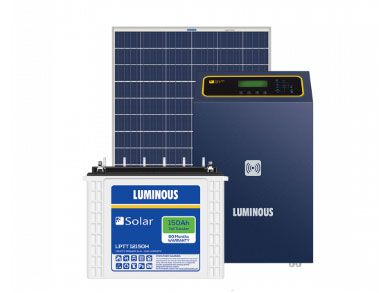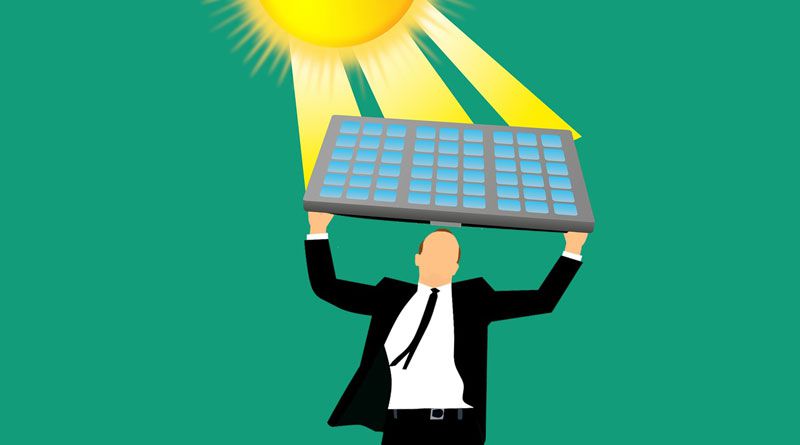Solar power has become the most utilized form of renewable energy today. Homeowners have mounted solar panel systems on their roofs to enjoy the benefits of solar power. Using semiconductor technology, solar panels, transform energy from the sunlight into electricity that can power your household appliances. There are various reasons you should use a solar system for home. Apart from the obvious financial benefits in terms of reduced electricity bills, the installation of a solar system at home helps mitigate greenhouse gas emissions and reduces our mutual dependency on fossil fuels. The government also provides tax incentives to those who install a solar system for home . The government pays upto 30 percent of the construction cost as a subsidy to the installer, as per the Ministry of New and Renewable Energy.

Image Courtesy: Luminous
There are many parameters to be considered when it comes to installing a solar system for home. And you would want to make an informed decision because you are investing in equipment that will last several years. Solar systems for home can be categorized into two types:
ON GRID Solar System
This solar system does not come with batteries and is connected to the public electricity grid using either solar inverters or micro-inverters. Electricity produced by solar panels is used to run home appliances and excess electricity is exported to grid which further helps in reducing your electricity bills.
OFF-GRID Solar System
An off-grid solar system is not connected to the national grid and hence requires batteries to store the generated electricity. They must be well built such that they produce ample power throughout the year and have sufficient battery capacity to meet your home requirements, even in winter when there is less or no sunshine.
The difference between OFF GRID and ON GRID solar system for home.
Accessibility To Electricity
You will still have access to power (unless the grid goes down) if you plan to install an on-grid solar system. It can either be the power generated by the panels or from the national grid. Such as, if your system does not generate enough electricity to fuel the appliances, you can extract energy from the grid to supplement it. This ensures that you always have ample electricity to run your appliances.
On the other hand, you are dependent on the sun and energy stored in batteries with an off-grid solar system to power your home or company. If you don’t have batteries for storage then, you’ll have less or no electricity at night or on a cloudy day.
Power Outages
With an on grid solar system for home, you get access to electricity whenever you need it by connecting to the grid. But if the grid goes down, you will have no power unless you opt for a off grid solar system which comes with battery backup.
The off grid solar system for home operates independently of the electricity grid. Your solar system will continue to run even if there is a bad storm or incident that knocks the power out. You will not find any changes in your accessibility to power. Most solar systems propagators suggest building an on-grid solar system. Nevertheless, the off-grid system can be a viable option for remote areas where the grid is inaccessible or unreliable. Some of the reputed and trusted brands like Luminous give you many options to choose the ideal solar system for your home. Eventually, it all boils down to taking an informed decision by comparing both pros and cons and keeping in mind the geography and climate of the place you stay.

Namaste UI collaborates closely with clients to develop tailored guest posting strategies that align with their unique goals and target audiences. Their commitment to delivering high-quality, niche-specific content ensures that each guest post not only meets but exceeds the expectations of both clients and the hosting platforms. Connect with us on social media for the latest updates on guest posting trends, outreach strategies, and digital marketing tips. For any types of guest posting services, contact us on info[at]namasteui.com.


Amazing blog! The best inverter for an average household, according to my personal experience, would be UTL’s solar panel inverter. Which has all the technological integration required for meeting the electrical demand of an average-sized house. You should explore the amazing range of inverters by UTL Solar.
Solar panels are also known as photovoltaic solar modules, solar plates, solar PV modules, and solar power panels, etc. The solar cells in a solar panel are made by melting silicon fragments or silicon crystals together in a mold and cutting them into wafers. Usually, there are a bunch of 60 or 72 individual crystalline silicon solar cells, connected together and covered with transparent glass. The more interconnected cells in a series, the more electricity generated by the solar panel.